Physical Address
304 North Cardinal St.
Dorchester Center, MA 02124
The mandible and maxilla are unique bones in that they both contain teeth and tooth-forming tissues. This fact is responsible for the high rate of inflammatory diseases, such as osteomyelitis and of lesions of odontogenic origin and other possible bone-related diseases. Because of this wide spectrum of disease, the interpretation of diagnostic images of the maxilla and mandible can be difficult. The following are some guidelines that are not infallible but are reliable, in most cases, and will assist in the diagnosis of mandibular and maxillary lesions.
The geographic center or epicenter of the lesion will indicate the possible tissue types or, in some cases, the cause of the lesion. For instance, lesions with an epicenter below the inferior alveolar canal are not likely to be odontogenic; benign lesions within the canal will likely be vascular or neural, and lesions above the canal are more likely to be odontogenic. Lesions involving the maxillary sinus that originate within the maxilla but outside of the sinus are more likely to be odontogenic. There are also prevalent sites for diseases; for example, periapical cemental dysplasia will have an epicenter at the apical region of a tooth no matter what the orientation of the tooth is within the jaw. In order to use the teeth as landmarks in establishing the location of a lesion, one must be cognizant of the normal dental anatomy. Essential structures include the root apex, crown, cementoenamel junction, periodontal membrane space, and lamina dura ( eFig. 115-1 ).

The definition and the structure of the periphery are also useful. Benign lesions tend to have better-defined peripheries, and the presence of a soft tissue capsule or a cortical border or sclerotic borders is significant. A round or hydraulic shape or a lesion with a scalloped border (series of contiguous arcs) often indicates a cyst or cyst-like lesion. For the purposes of this chapter, a blending border is an ill-defined border where there is a transition between normal trabeculae and abnormal trabeculae, and a permeative border is one of ill-defined bone destruction.
The shape and density of the internal radiopaque elements may indicate tooth structure or, in the case of multilocular lesions, the internal septa can indicate the type of tumor or cyst.
The effects of disease on surrounding structures are of particular importance, and the clinician must have a profound understanding of the mechanisms of diseases of the jaws. For instance, most cysts grow by osmotic pressure, but odontogenic keratocysts, which are lined by epithelium that has a higher mitotic rate, have a different mechanism of growth and, therefore, will have a different appearance. Benign lesions are more likely than malignant lesions to occupy space by displacing teeth and causing tooth resorption.
Periapical inflammatory disease is the local bone response at the tooth apex to the necrosis of the pulp of the tooth that may have many possible causes, such as caries, severe periodontal disease, or trauma.
Location: The epicenter is within the periodontal ligament space at the root apex, and the extent is variable ( eFig. 115-2A and 115-2C ).
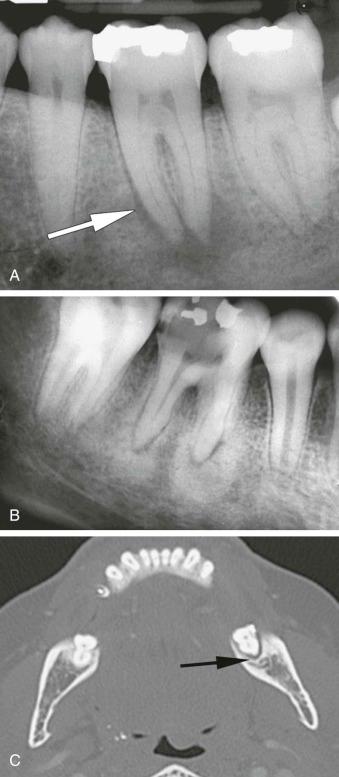
Periphery: The border is ill-defined and blending (gradual change in number and size of surrounding trabeculae).
Internal structure: The internal aspect is variable with early lesions mostly radiolucent and chronic lesions more sclerotic (see eFig. 115-2B ).
Effects on surrounding structures: There is widening of periodontal ligament space, with the greatest degree at the root apex, and associated destruction of lamina dura. In almost all cases, there is a peripheral sclerotic bone reaction of variable width. This inflammatory lesion may stimulate periosteal new bone formation on the external bone surface or floor of the sinus and/or a localized mucositis within the sinus. Resorption of a portion of the involved tooth root may be seen. This localized inflammatory lesion has the potential to extend into surrounding bone and progress to an osteomyelitis.
The early stage of periapical cemental dysplasia (PCD) may be difficult and impossible to differentiate from periapical pathology. A clinical vitality test of the involved tooth would be useful. A less common differential diagnosis would be metastatic lesions (e.g., breast carcinoma) or malignancies, such as malignant lymphoma infiltrating the mandible.
Periodontal disease is a chronic infectious disease incited by bacterial plaque that stimulates an inflammatory response that involves and destroys the periodontal ligament and supporting bone of the teeth.
Location: The epicenter is at the crest of the alveolar process involving the adjacent periodontal ligament space and supporting bone of the adjacent tooth ( eFig. 115-3 ).
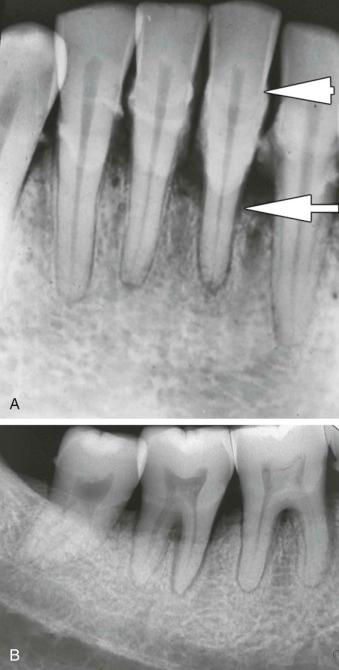
Periphery: The periphery is most often ill-defined with blending borders.
Internal structure: Where there is bone destruction, the internal structure is radiolucent.
Effects on surrounding structures: There is usually a peripheral sclerotic bone reaction of varying extent, and there may be a secondary localized mucositis within the floor of the maxillary sinus. In rare cases, there may be external root resorption of the involved teeth.
Active periodontal disease would be a common cause of abnormal bone activity of the jaws on technetium scintigraphy.
The major lesions to consider are squamous cell carcinoma, which may appear identical to periodontal disease but will usually involve one isolated area, and Langerhans cell histiocytosis, which usually is multifocal and has an epicenter at the mid-root region, giving the leading edge of bone destruction a scooped-out appearance.
Osteomyelitis (acute suppurative osteomyelitis, pyogenic osteomyelitis, subacute suppurative osteomyelitis, Garré osteomyelitis, periostitis ossificans, chronic diffuse sclerosing osteomyelitis, chronic nonsuppurative osteomyelitis) is an inflammatory disease of bone stimulated by infectious organisms. The most common source in the jaws is an infectious process involving teeth; and, in rare cases, the disease results from hematogenous spread. The inflammatory response in the mandible can be quite extensive in response to a small region of infection. Usually, the infectious agent cannot be found and identified. The mandibular inflammatory response may be profound, with extensive sclerotic bone reaction compromising vascularity and, therefore, promoting a cyclic chronic disease. Historically, there have been numerous unnecessary subdivisions of osteomyelitis of the jaws that merely represent a spectrum of inflammatory response from acute to chronic stages.
Location: The most common site is the posterior body and ramus of the mandible; it is rare in the maxilla ( eFig. 115-4 ).
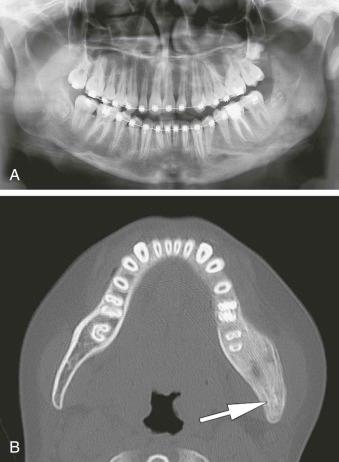
Periphery: There is usually an ill-defined blending border.
Internal structure: The internal aspect is variable, depending on stage of disease from lytic in acute stages, to a mix of lytic and sclerotic, to chronic stages with mostly sclerotic granular pattern. Sequestra may be present and are best seen on thin-slice bone algorithm CT images ( eFig. 115-5 ).
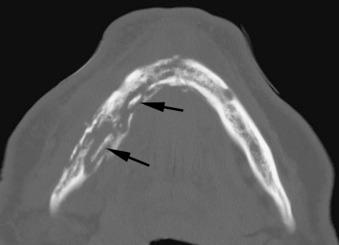
Effects on surrounding structures: There is a surrounding sclerotic bone response of variable extent. Most commonly there is reactive periosteal new bone formation, which may be exuberant in young patients and less apparent in chronic cases involving older patients. The most reliable imaging modality to detect periosteal reaction is CT ( eFig. 115-6 ).
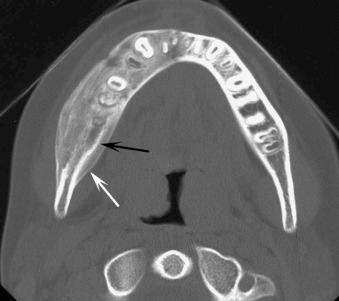
Because of the sclerotic bone reaction, there is low signal intensity in the bone marrow on T1-weighted images, and there may be high signal intensity on T2-weighted and short tau inversion recovery images due to the marrow edema. In chronic cases without significant edema, T2-weighted images may show low signal intensity in the bone marrow ( eFig. 115-7 ).
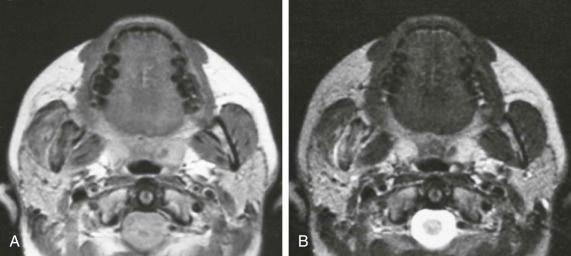
Technetium scintigrams are always positive, but the gallium or white blood cell scans are positive in acute but not chronic cases.
In the first 2 decades of life, fibrous dysplasia is the most common differential diagnosis. The presence of evidence of periosteal reactive bone at the leading edge of osteomyelitis is a useful differentiating characteristic (see eFig. 115-6 ). In older patients, florid osseous dysplasia, Paget disease, and osteogenic sarcoma would be considered. Also, on occasion, florid osseous dysplasia can become secondarily infected and develop a secondary osteomyelitis. Of all of the imaging modalities, CT is the imaging modality of choice for diagnosis.
Osteoradionecrosis is an inflammatory condition of bone that occurs after therapeutic exposure to radiation and results in necrotic bone. The exact mechanism of bisphosphonate osteonecrosis is unknown but may be related to disturbances in normal bone metabolism or changes to bone vascularity.
The radiographic changes of both of these entities are similar to those described in osteomyelitis, except there is rarely any periosteal reaction. In osteoradionecrosis, the changes can be predominantly sclerotic or lytic or a mixture. Often, parts of the outer cortical plate are resorbed or become sequestra. The detection of sequestra on radiographs is not reliable, and, therefore, CT is required (see Fig. 115-1 ).
Commonly, there is a sclerotic bone reaction after exposure to therapeutic levels of radiation; therefore, CT is required to detect necrotic bone (sequestra) to make the diagnosis ( eFig. 115-8 ). Exposure to therapeutic radiation may cause widening of the periodontal ligament space around exposed teeth that is identical to that of malignant changes ( eFig. 115-9 ).
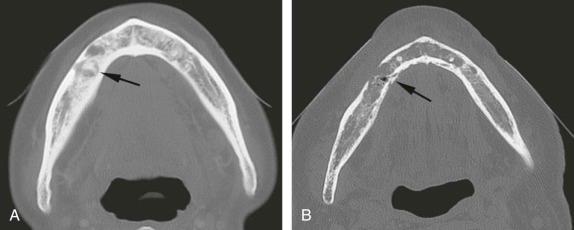
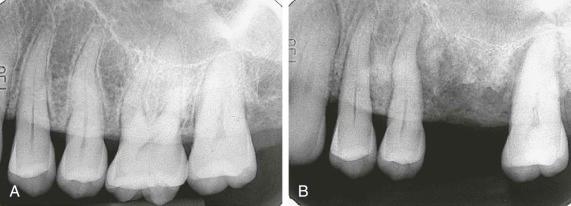
Cysts of the jaws can be odontogenic (derived from odontogenic epithelium) and nonodontogenic (no epithelial lining and therefore not true cysts). The differentiation depends mainly on location and on effects on surrounding structures. Healing cysts usually form new bone from the periphery toward the center (except for simple bone cysts) and may be mistaken for a bone-forming tumor. Only the more common cysts are discussed here.
Radicular cyst (periapical cyst, apical periodontal cyst, or dental cyst) arises from epithelial cells (Malassez) in the periodontal ligament, which are stimulated by the inflammatory products from the necrosis of the associated tooth pulp. If the tooth is extracted and the cyst remains, it is termed a residual cyst.
Location: The epicenter is at or immediately below the apex of the nonvital tooth ( eFig. 115-10 ).

Periphery: This cyst is usually surrounded by a thin curved cortical bone, unless the cyst is secondarily infected, which may result in the loss of the corticated border. When the maxillary sinus is involved, there is always a cortical border separating the internal structure of the cyst from the sinus ( eFig. 115-11 ).
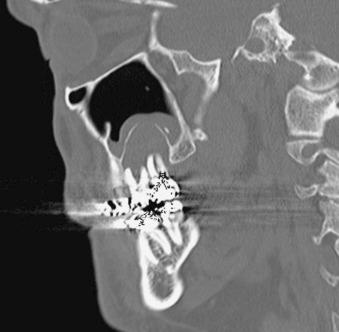
Internal structure: The internal aspect is usually radiolucent with the density of fluid on CT images (see eFig. 115-11 ). In long-standing chronic cysts, there may be a scattering of dystrophic calcification ( eFig. 115-12 ). Cysts may drain spontaneously or with treatment and collapse, forming new bone from the periphery ( eFig. 115-13 ).
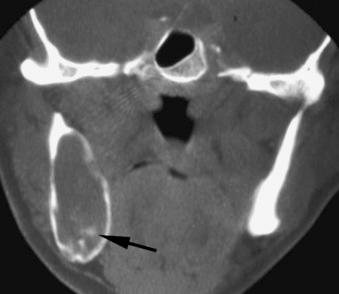
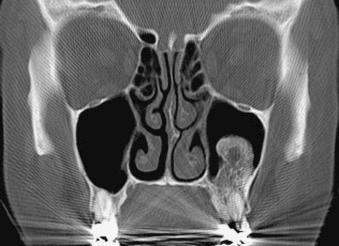
Effects on surrounding structures: This cyst has a tendency to expand the outer cortical plates of the jaws or boundaries of the sinus in a hydraulic shape. It can displace and resorb the roots of associated teeth ( eFig. 115-14 ).

The internal signal intensity is homogeneous and intermediate on T1-weighted images and homogeneous and high on T2-weighted images. If the cyst is secondarily infected, there may be peripheral signal enhancement on a post-gadolinium image.
Very small lesions cannot be differentiated from a periapical granuloma, which also results from a nonvital tooth. The periapical position is important in the differentiation from other cysts. A residual cyst may appear similar to other cysts and has a propensity for expansion and may be related to the socket of a missing tooth. A healing and collapsing cyst in the maxillary sinus may be misdiagnosed as an ossifying fibroma. The differentiation can be made by the organization of bone growing into the center from the periphery (see eFig. 115-13 ).
This cyst results when fluid collects within the follicular space of an unerupted tooth. By definition, this cyst must be located around the crown of a tooth and connected to the cementoenamel junction. The microscopic appearance of the lining epithelium is not diagnostic.
Location: The epicenter must be located above the coronal aspect of the involved tooth, and the cyst must be connected to the cementoenamel junction of the tooth ( eFig. 115-15 ).
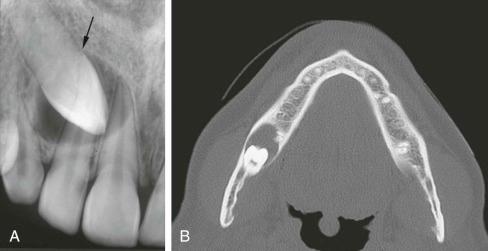
Periphery: The cyst is surrounded by a thin, curved, corticated periphery, unless secondarily infected. The peripheral cortex should separate the internal aspect of the cyst from the maxillary sinus ( eFig. 115-16 ).
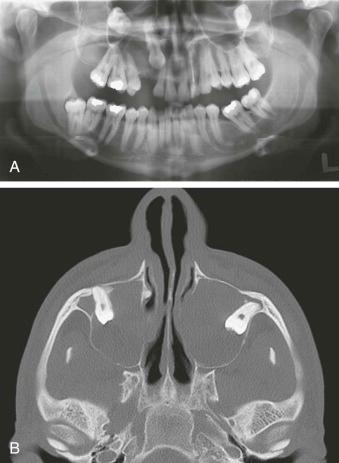
Internal structure: The internal aspect is radiolucent and has the density of fluid on soft tissue algorithm CT images. As in radicular cysts, long-standing cysts may develop internal dystrophic calcification.
Effects on surrounding structures: This cyst has a strong propensity to displace the involved tooth in an apical direction and resorb and displace adjacent teeth ( eFig. 115-17 ). It characteristically expands the outer cortical boundaries of the jaws in a concentric or hydraulic shape and may occupy the entire maxillary sinus ( eFig. 115-18 ).
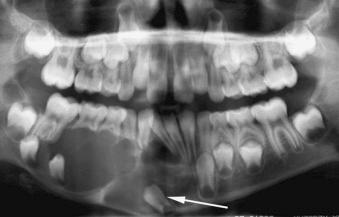
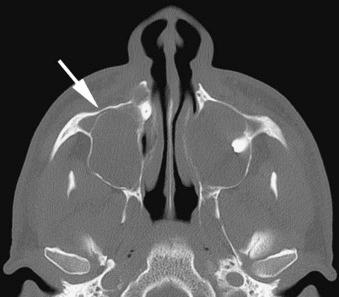
The internal signal intensity can range from homogeneously low to intermediate on T1-weighted images and homogeneous high signal intensity on T2-weighted images.
In the absence of effects on surrounding structures and when it is small, the dentigerous cyst cannot be differentiated from a hyperplastic tooth follicle. It may also be very similar to a small ameloblastic fibroma or a small unicystic ameloblastoma. Larger ameloblastomas should cause considerable expansion that will often outstrip periosteal response and lose the peripheral cortication. Other rare odontogenic tumors, such as adenomatoid odontogenic tumors and calcified odontogenic cysts, may have similar pericoronal positions. The odontogenic keratocyst may have a pericoronal position, but, often, the keratocyst does not expand as much and has a tendency to grow along the bone. Large dentigerous cysts that occupy most of the maxillary sinus may be difficult to differentiate from an antral mucocele, although the presence of a double cortex (cyst and antral walls) at the periphery will identify the presence of a cyst (see eFig. 115-18 ).
This cyst arises from the epithelium of the dental lamina; and, unlike other cysts, osmotic pressure is not the primary mechanism of growth, but there is an innate growth potential similar to that of a benign tumor. This difference in growth mechanism results in a different behavior compared with other cysts. Both the distinctive delicate, thin, keratinized epithelium that can fragment easily during surgery and the presence of small satellite cysts around the periphery are reasons for a potentially high recurrence rate compared with other cysts. Multiple odontogenic keratocysts are associated with basal cell nevus syndrome.
Location: This cyst occurs more commonly in the mandible than maxilla and within the mandible more commonly in the posterior body and ramus. Occasionally, it has a pericoronal position.
Periphery: The periphery is usually corticated unless secondarily infected and may have a scalloped shape ( eFig. 115-19 ).
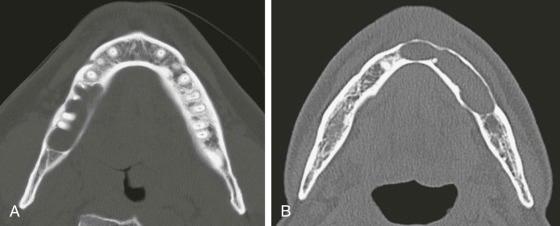
Internal structure: This may be completely radiolucent or may have curved septa and rarely straight septa ( eFig. 115-20 ).
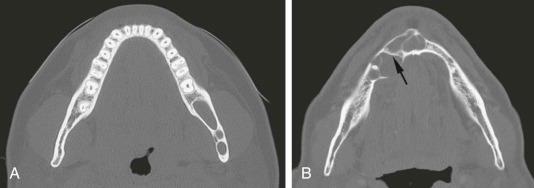
Effects on surrounding structures: There is a distinctive growth pattern along the mandible with slight expansion, but it is not as expansile as other cysts. When expansion does occur, it will involve the upper ramus and coronoid process ( eFig. 115-21 ). This cyst can displace teeth and may resorb the roots of adjacent teeth but not as commonly as with other cysts. CT often reveals breaks in the outer cortical border of the mandible where there may be soft tissue contact but no invasion into the surrounding soft tissues ( eFig. 115-22 ).
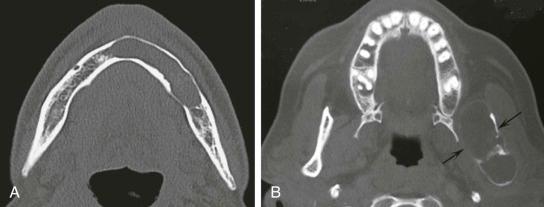
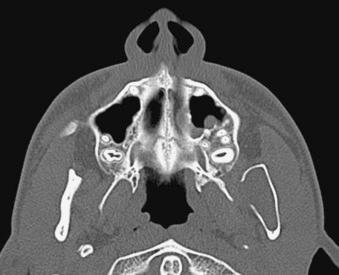
T1-weighted images typically have an intermediate homogeneous or heterogeneous signal intensity, and, on post-gadolinium T1-weighted images, there may be enhancement of the peripheral signal, especially if the cyst is inflamed. The T2-weighted images reveal heterogeneous high signal intensity. The heterogeneous internal signal intensity may depend on the amount of internal keratin formation ( eFig. 115-23 ).
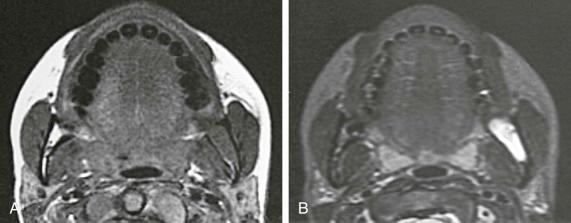
The lack of significant expansion and a scalloped border are similar to the appearance of simple bone cysts. The presence of well-defined cortical borders, internal septa, displacement and resorption of teeth, and loss of the outer cortical border of the involved jaw are more common in keratocysts. Small cysts in a pericoronal position may be indistinguishable from follicular cysts.
Epithelial cell rests in the buccal periodontal ligament space of mandibular molars appear to be the source for this cyst. It is postulated that inflammation stimulates cell proliferation. The histologic characteristics of the epithelial lining are not characteristic, and diagnosis depends on imaging characteristics.
Location: This cyst is located in the buccal furcation region of mandibular molars, most commonly the first molar ( eFig. 115-24 ).
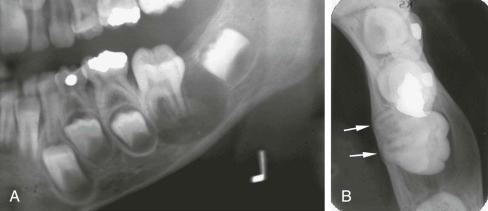
Periphery: There is usually a corticated border unless there is secondary infection, and often there is no evidence of a peripheral cortication. The shape is hydraulic.
Internal structure: The cyst is radiolucent with a density of fluid evident on CT.
Effects on surrounding structures: A distinctive tipping of the involved mandibular molar so that the roots are pushed into the medial cortical plate of the mandible and the crown is pushed toward the lateral aspect is a diagnostic behavior of this cyst. Often there is expansion of the buccal cortical plate, but, if the cyst is secondarily infected, the expansion may not be apparent, and there may be an inflammatory periosteal reaction ( eFig. 115-25 ).
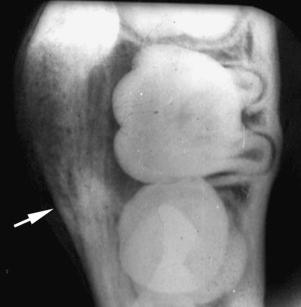
Become a Clinical Tree membership for Full access and enjoy Unlimited articles
If you are a member. Log in here